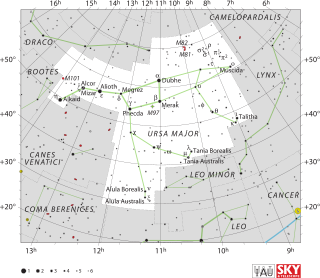큰곰자리 4
4 Ursae Majoris| 관측 데이터 Epoch J2000.0 이쿼녹스 J2000.0 | |
|---|---|
| 별자리 | 우르사 메이저 |
| 우측 상승 | 08h 40m 12.81767s[1] |
| 탈위임 | +64° 19′ 40.5700″[1] |
| 겉보기 크기 (V) | +4.620[2] |
| 특성. | |
| 스펙트럼형 | K2 III[3] |
| U-B색지수 | +1.193[2] |
| B-V색지수 | +1.159[2] |
| 아스트로메트리 | |
| 방사 속도 (Rv) | +14.62km[4]/s |
| 고유 운동 (μ) | RA: −60.05[1]mas/yr Dec.: +26.40[1]mas/yr |
| 시차 (π) | 12.74 ± 0.26[1] 마스 |
| 거리 | 256 ± 5 리 (78 ± 2 pc) |
| 절대치수 (MV) | 0.150[3] |
| 세부 사항 | |
| 미사 | 1.234 ± 0.15[5] M☉ |
| 반지름 | 18.79±0.38[6] R☉ |
| 루미도 | 112.4±10.0[6] L☉ |
| 표면 중력 (log g) | 1.8 ± 0.15[5] cgs |
| 온도 | 4336±99[6] K |
| 금속성 [Fe/H] | -0.25 ± 0.04[5] 덱스를 만들다 |
| 회전 속도 (v sin i) | 초속[7] 8km/s |
| 나이 | 4.18 ± 1.95[3] Gyr |
| 기타 지정 | |
| 데이터베이스 참조 | |
| 심바드 | 자료 |
4 Ursae Majoris(때로는 약칭 4 Uma)는 Ursa Major의 북쪽 순환 별자리에 있는 별의 Flamsteed 명칭이다.또한2 바이엘 명칭인 피 우르새 마조리스(Pi2 UMA, ur2 Ursae Majoris, um2 UMA)를 포함하고 있으며, 전통적으로 무스카이다(Muscida)라는 이름이 붙었다.가시적 크기가 +4.6인 이 별은 보틀 다크-스카이 스케일을 바탕으로 교외나 어두운 하늘에서 볼 수 있다.[2]히파르코스 임무 중 행해진 시차 측정에서 이 별은 지구로부터 256광년(78파섹) 거리에 있다.[1]2011년[update] 현재, 한 개의 외계 행성이 이 별 주위를 돌고 있는 것으로 확인되었다.
특성.
이 별은 K2 III의 별 분류를 가지고 있어 약 40억 년의 추정 연령이 되었을 때,[3] 거대한 단계에 도달한 진화된 별이라는 것을 보여준다.[3]태양보다 약 1.2배 큰 질량을 가지지만 태양의 둘레의 18배까지 팽창했다.[5]항성 외부 대기의 유효 온도는 4,415 K이다.[5]이 열은 K형 별의 시원한 오렌지색 빛을 준다.[8]
피우르새마조리는2 은하수의 얇은 원반 개체군 중 하나이다.그것은 은하계를 통과하는 궤도를 따라 0.10의 기이한 궤도를 따라가고 있으며, 은하중심에는 27.7킬로나이트(8.5킬로파섹), 은하중심에는 34.1kly(10.5kpc)까지 근접해 있다.이 궤도의 기울기는 은하계에 가까우므로 260 ly (80 pc) 이하로는 이 비행기를 출발시킨다.[3]
행성계
별에서 관측된 방사상 속도 변화에 기초하여 2007년에 행성 동반자의 존재가 발표되었다.4 Ursae Majoris b로 지정된 이 행성은 목성보다 최소 7배 더 크다.그것의 궤도는 편심이며, 태양에서 지구까지의 거리 87%로 4 Ursae Majoris 궤도를 돌고 있다.태양에 비해 이 별은 천문학자들이 별의 야금성이라고 부르는 수소와 헬륨 이외의 원소의 풍부함이 낮다.행성이 있는 대부분의 주계열성 별들은 금속이 더 많은 경향이 있기 때문에 이것은 의아하다.[5]
| 동반자 (별에서 순서대로) | 미사 | 세미마조르 축 (AU) | 궤도 주기 (일) | 편심성 | 기울기 | 반지름 |
|---|---|---|---|---|---|---|
| b | >7.1 ± 1.6MJ | 0.87 ± 0.04 | 269.3 ± 1.96 | 0.432 ± 0.024 | — | — |
명명 및 어원
π1, σ1, σ2, ρ, A, d와 함께 아라비아의 별자리 알 지바야, 가젤을 작곡했다.[9]According to the catalogue of stars in the Technical Memorandum 33-507 - A Reduced Star Catalog Containing 537 Named Stars, Al Ṭhibā were the title for seven stars: A as Althiba I, π1 as Althiba II, this star (π2) as Althiba III, ρ as Althiba IV, σ1 as Althiba V, σ2 as Althiba VI, and d as Althiba VII.[10]
참고 항목
참조
- ^ a b c d e f van Leeuwen, F. (November 2007), "Validation of the new Hipparcos reduction", Astronomy and Astrophysics, 474 (2): 653–664, arXiv:0708.1752, Bibcode:2007A&A...474..653V, doi:10.1051/0004-6361:20078357, S2CID 18759600
- ^ a b c d Jennens, P. A.; Helfer, H. L. (September 1975), "A new photometric metal abundance and luminosity calibration for field G and K giants", Monthly Notices of the Royal Astronomical Society, 172 (3): 667–679, Bibcode:1975MNRAS.172..667J, doi:10.1093/mnras/172.3.667
- ^ a b c d e f Soubiran, C.; et al. (2008), "Vertical distribution of Galactic disk stars. IV. AMR and AVR from clump giants", Astronomy and Astrophysics, 480 (1): 91–101, arXiv:0712.1370, Bibcode:2008A&A...480...91S, doi:10.1051/0004-6361:20078788, S2CID 16602121
- ^ Famaey, B.; et al. (January 2005), "Local kinematics of K and M giants from CORAVEL/Hipparcos/Tycho-2 data. Revisiting the concept of superclusters", Astronomy and Astrophysics, 430: 165–186, arXiv:astro-ph/0409579, Bibcode:2005A&A...430..165F, doi:10.1051/0004-6361:20041272, S2CID 17804304
- ^ a b c d e f g Döllinger, M. P.; et al. (2007), "Discovery of a planet around the K giant star 4 Ursae Majoris", Astronomy and Astrophysics (abstract), 472 (2): 649–652, arXiv:astro-ph/0703672, Bibcode:2007A&A...472..649D, doi:10.1051/0004-6361:20066987, S2CID 17662368
- ^ a b c Baines, Ellyn K.; et al. (2010). "Angular Diameters and Effective Temperatures of 25 K Giant Stars from the CHARA Array". Astrophysical Journal. 710 (2): 1365–1374. arXiv:0912.5491. Bibcode:2010ApJ...710.1365B. doi:10.1088/0004-637X/710/2/1365. S2CID 799107.
- ^ Bernacca, P. L.; Perinotto, M. (1970), "A catalogue of stellar rotational velocities", Contributi Osservatorio Astronomico di Padova in Asiago, 239 (1): 1, Bibcode:1970CoAsi.239....1B
- ^ "The Colour of Stars", Australia Telescope, Outreach and Education, Commonwealth Scientific and Industrial Research Organisation, December 21, 2004, archived from the original on February 22, 2012, retrieved 2012-01-16
- ^ Allen, Richard Hinckley (1899), Star-Names and Their Meanings, New York: G. E. Stechert, p. 444
- ^ Rhoads, Jack W. (November 15, 1971), Technical Memorandum 33-507-A Reduced Star Catalog Containing 537 Named Stars (PDF), Jet Propulsion Laboratory, California Institute of Technology.
외부 링크
- Jean Schneider (2011). "Notes for star 4 Uma". Extrasolar Planets Encyclopaedia. Archived from the original on 10 February 2012. Retrieved 3 October 2011.



